- Joined
- Feb 2, 2011
- Messages
- 2,153
NEW RELEASES FOR JULY 2020
THE EIGHTEENTH CENTURY COLLECTION
DRUMS ALONG THE MOHAWK
THE BATTLE OF SARATOGA 1777,
“The surrender that changed the world”.
In October 1777, a 6,000 strong British army surrendered in defeat after the American victory at the Battles of Saratoga.
For the first time in history a British General surrendered his sword
Burgoyne's strategy to divide New England from the southern colonies had started well but slowed due to logistical problems. He won a small tactical victory over General Horatio Gates and the Continental Army in the September 19 Battle of Freeman's Farm at the cost of significant casualties.
THE FIRST BATTLE OF SARATOGA 1777
THE BATTLE OF FREEMAN’S FARM, SEPTEMBER 19[SUP]th[/SUP] 1777
ANGLO-ALLIED ARMY
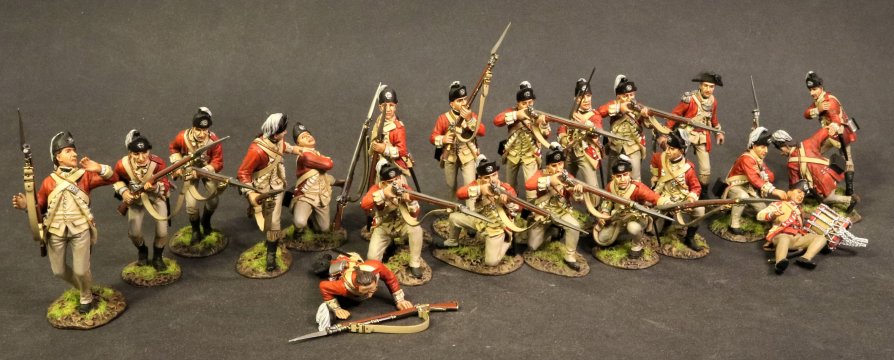
The 62nd Regiment of Foot was an infantry regiment of the British Army, which was raised in 1756 and saw service through the eighteenth and nineteenth centuries. Under the Childers Reforms it amalgamated with the 99th (Lanarkshire) Regiment of Foot to form the Wiltshire Regiment in 1881.
In October 1756 a second battalion to the 4th Regiment of Foot was formed as part of measures to strengthen the army at the start of the Seven Years' War with France.
In January 1758 four companies of the 2nd/4th Regiment embarked at Plymouth as Marines under Major T Hardy in five ships of Admiral Boscawen's fleet while Battalion Headquarters and the remaining companies stayed at Plymouth. The fleet sailed for Halifax, Nova Scotia, the base for a seaborne attack on French Canada. However, on 21 April while the fleet was part way across the Atlantic came news of a change of name following an official decree that the new second battalions throughout the Army would be numbered as separate regiments. Under this re-organisation the 2nd/4th Regiment became the 62nd Regiment of Foot.
Throughout the Canadian campaign the 62nd continued to serve as Marines, providing landing parties, manning ships' boats, putting artillery pieces ashore and providing local protection for them. During this time the Regiment won its first Battle Honour 'Louisburg' in 1758, but it was not awarded until 152 years later. The reason for this was that since they were employed on board ship the men were on the strength of the navy, not the army, so that at the time the War Office stated they had no record of the Regiment's participation!
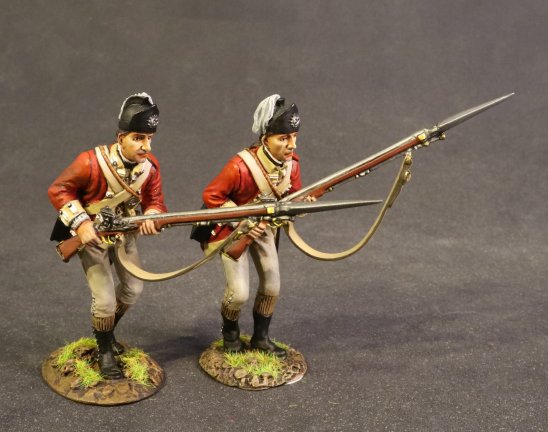
S62-10
DRUMS ALONG THE MOHAWK,
THE BATTLE OF SARATOGA 1777,
THE ANGLO ALLIED ARMY,
THE 62[SUP]nd[/SUP] REGIMENT OF FOOT,
2 INFANTRY ADVANCING.
(2pcs)
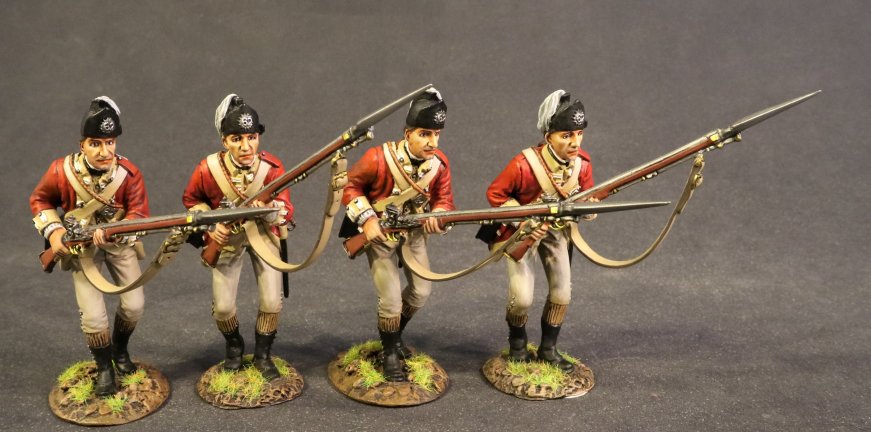
S62-10N
DRUMS ALONG THE MOHAWK,
THE BATTLE OF SARATOGA 1777,
THE ANGLO ALLIED ARMY,
THE 62[SUP]nd[/SUP] REGIMENT OF FOOT,
4 INFANTRY ADVANCING.
(4pcs)
BUTLER’S RANGERS
Butler's Rangers (1777–1784) was a Loyalist, British provincial military unit of the American Revolutionary War, raised by Loyalist John Butler. Most members of the regiment were Loyalists from upstate New York.
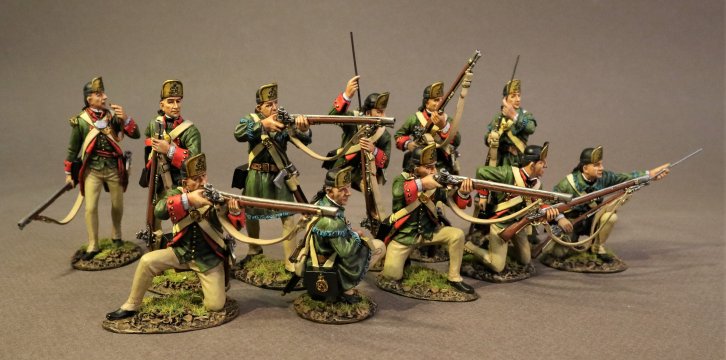
John Butler was a French and Indian War veteran-turned landowner with a 26,000 acre estate near Caughnawaga in the Mohawk Valley. However, on the outbreak of American Revolutionary War, Butler abandoned these landholdings and fled to Canada in the company of other Loyalist leaders, such as the Iroquois chief, Joseph Brant.
During the Saratoga Campaign Lieutenant Colonel Butler distinguished himself at the Battle of Oriskany on August 6, 1777. As a result, he was commissioned a lieutenant colonel and allowed to raise his own British provincial regiment. This military group would come to be known as Butler's Rangers.
Similar to other Loyalist regiments that fought for the British Crown during the American Revolution, Butler's Rangers were made up of American Loyalist refugees who had fled to Canada, following the outbreak of the American Revolution.
The Rangers were accused of participating in — or at least failing to prevent — the Wyoming Valley massacre of July 1778 and the Cherry Valley massacre of November 1778 of European settlers (including some Loyalists) by Iroquois forces under the command of Joseph Brant. These actions earned the Rangers a reputation for ruthlessness no holds barred warfare tactics. They fought principally in Western New York and Pennsylvania, but ranged as far west as Ohio and Michigan and as far south as Virginia.
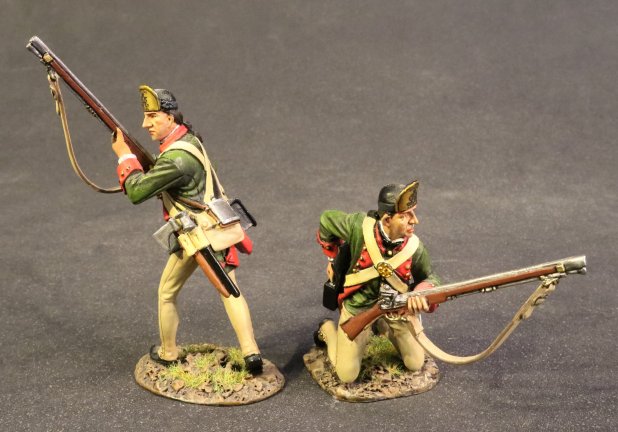
BUTT-06
DRUMS ALONG THE MOHAWK,
“THE DESTRUCTIVES”,
BUTLER’S RANGERS,
2 RANGERS SKIRMISHING.
(2pcs)
Their winter quarters were constructed on the west bank of the Niagara River, in what is now Niagara-on-the-Lake, Ontario
**PLEASE CONTACT YOUR LOCAL DEALER FOR FURTHER INFORMATION**
THE EIGHTEENTH CENTURY COLLECTION
DRUMS ALONG THE MOHAWK
THE BATTLE OF SARATOGA 1777,
“The surrender that changed the world”.
In October 1777, a 6,000 strong British army surrendered in defeat after the American victory at the Battles of Saratoga.
For the first time in history a British General surrendered his sword
Burgoyne's strategy to divide New England from the southern colonies had started well but slowed due to logistical problems. He won a small tactical victory over General Horatio Gates and the Continental Army in the September 19 Battle of Freeman's Farm at the cost of significant casualties.
THE FIRST BATTLE OF SARATOGA 1777
THE BATTLE OF FREEMAN’S FARM, SEPTEMBER 19[SUP]th[/SUP] 1777
ANGLO-ALLIED ARMY

The 62nd Regiment of Foot was an infantry regiment of the British Army, which was raised in 1756 and saw service through the eighteenth and nineteenth centuries. Under the Childers Reforms it amalgamated with the 99th (Lanarkshire) Regiment of Foot to form the Wiltshire Regiment in 1881.
In October 1756 a second battalion to the 4th Regiment of Foot was formed as part of measures to strengthen the army at the start of the Seven Years' War with France.
In January 1758 four companies of the 2nd/4th Regiment embarked at Plymouth as Marines under Major T Hardy in five ships of Admiral Boscawen's fleet while Battalion Headquarters and the remaining companies stayed at Plymouth. The fleet sailed for Halifax, Nova Scotia, the base for a seaborne attack on French Canada. However, on 21 April while the fleet was part way across the Atlantic came news of a change of name following an official decree that the new second battalions throughout the Army would be numbered as separate regiments. Under this re-organisation the 2nd/4th Regiment became the 62nd Regiment of Foot.
Throughout the Canadian campaign the 62nd continued to serve as Marines, providing landing parties, manning ships' boats, putting artillery pieces ashore and providing local protection for them. During this time the Regiment won its first Battle Honour 'Louisburg' in 1758, but it was not awarded until 152 years later. The reason for this was that since they were employed on board ship the men were on the strength of the navy, not the army, so that at the time the War Office stated they had no record of the Regiment's participation!

S62-10
DRUMS ALONG THE MOHAWK,
THE BATTLE OF SARATOGA 1777,
THE ANGLO ALLIED ARMY,
THE 62[SUP]nd[/SUP] REGIMENT OF FOOT,
2 INFANTRY ADVANCING.
(2pcs)

S62-10N
DRUMS ALONG THE MOHAWK,
THE BATTLE OF SARATOGA 1777,
THE ANGLO ALLIED ARMY,
THE 62[SUP]nd[/SUP] REGIMENT OF FOOT,
4 INFANTRY ADVANCING.
(4pcs)
BUTLER’S RANGERS
Butler's Rangers (1777–1784) was a Loyalist, British provincial military unit of the American Revolutionary War, raised by Loyalist John Butler. Most members of the regiment were Loyalists from upstate New York.

John Butler was a French and Indian War veteran-turned landowner with a 26,000 acre estate near Caughnawaga in the Mohawk Valley. However, on the outbreak of American Revolutionary War, Butler abandoned these landholdings and fled to Canada in the company of other Loyalist leaders, such as the Iroquois chief, Joseph Brant.
During the Saratoga Campaign Lieutenant Colonel Butler distinguished himself at the Battle of Oriskany on August 6, 1777. As a result, he was commissioned a lieutenant colonel and allowed to raise his own British provincial regiment. This military group would come to be known as Butler's Rangers.
Similar to other Loyalist regiments that fought for the British Crown during the American Revolution, Butler's Rangers were made up of American Loyalist refugees who had fled to Canada, following the outbreak of the American Revolution.
The Rangers were accused of participating in — or at least failing to prevent — the Wyoming Valley massacre of July 1778 and the Cherry Valley massacre of November 1778 of European settlers (including some Loyalists) by Iroquois forces under the command of Joseph Brant. These actions earned the Rangers a reputation for ruthlessness no holds barred warfare tactics. They fought principally in Western New York and Pennsylvania, but ranged as far west as Ohio and Michigan and as far south as Virginia.

BUTT-06
DRUMS ALONG THE MOHAWK,
“THE DESTRUCTIVES”,
BUTLER’S RANGERS,
2 RANGERS SKIRMISHING.
(2pcs)
Their winter quarters were constructed on the west bank of the Niagara River, in what is now Niagara-on-the-Lake, Ontario
**PLEASE CONTACT YOUR LOCAL DEALER FOR FURTHER INFORMATION**

